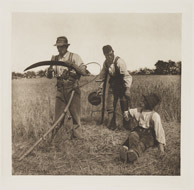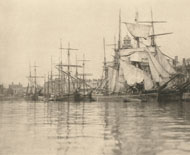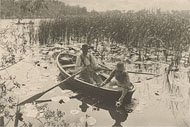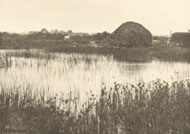 |

 |
 |
The Old Order and the New, 1886
|
 |
This exhibition explores British photographer Peter Henry Emerson's decade-long work to document the people and landscape of the Norfolk Broads, a network of freshwater rivers, lakes, and marshes in East Anglia, on England's eastern shore. Drawn to rural subjects, Emerson was fascinated by the region's traditional ways of life and concerned that they were threatened by industrialization and tourism.
From 1885 to 1895 Emerson used the latest photographic processes to document the region's traditions and landscape, which he felt was in danger of disappearing. The new technology of photomechanical reproduction made it possible for Emerson to mass-produce his photographs and to create a prolific output of books, portfolios, and individual works on the subject.
|
 |

 |
 |
The Old Order and the New, detail, 1886
|
 |
 |
Emerson titled the photograph above The Old Order and the New to reflect changes occurring in the late 19th century whereby traditional agriculture was increasingly threatened by mechanization and tourism. In the image (see detail at left), the old order, represented by the derelict windmill at far left, is replaced by the new, steam-driven wheels of the dredging mill. The same wind blows smoke from the chimney and powers the sails of the boat in the center.
|
 |
|
When railways made the Norfolk Broads more accessible, tourism flourished as this area was seen as a bucolic escape from the congested urban life of industrialized England. Emerson disliked tourism, and the work of tourist-photographers, whose pictures he perceived as promoting the demise of the old order he honored.
Emerson made the image seen here for a book about angling (fishing with a hook) for trout. Rather than provide an illustration of the popular local sport, his image of a lone fisherman dwarfed by his surroundings, with the old stone bridge and church, creates a more symbolic composition of man's relation to the natural landscape.
|
 |

 |
 |
In the Barley Harvest, 1890
|
 |
 |
|
|
 |
Emerson saw himself as an anthropologist of types. Through his photographs of East Anglian hunters, gamekeepers, farmworkers, and fishermen, he hoped to preserve, at least photographically, these traditional ways of life, which he believed were at risk of becoming obsolete. He endeavored to be the guardian of the rural social order, but his images present idealized types that match his subjective vision.
Emerson opposed modern machinery encroaching upon the traditions of the countryside. He once said, "No machine will be invented which will do the work as well as the scythe." The subject of a mower sharpening his blade, as seen in this image, also appeared often in late 19th-century paintings.
|
 |
|
Gathering Water-Lilies is arguably Emerson's best known photograph and certainly his most widely reproduced. Realized first as an albumen silver print (as all Emerson photographs were), the image was subsequently published as a photogravure in two highly successful editions (a deluxe set and an ordinary set) before Emerson produced the platinum version for his first publication, Life and Landscape on the Norfolk Broads, in 1886.
The subject, seemingly peaceful and romantic, actually records workers collecting flowers to use as bait for fishing. The book and many of its images were the result of a partnership between Emerson and the painter Thomas Frederick Goodall, who journeyed together around the Norfolk Broads in 1885. They interacted with the locals, recorded their traditions, and presented a view of the countryside that was aimed at "lovers of art."
|
 |

 |
 |
Rowing Home the Schoof-Stuff, 1886
|
 |
 |
|
|
 |
In Emerson's time, the question of whether photographs should be in or out of focus was the subject of intense debate within photographic circles. One school believed that photography's defining characteristic was its "truthfulness" and ability to capture detail with startling clarity. Others felt that selecting the degree of focus in different parts of a photograph—using a technique known as differential focus—resulted in an image that was, in fact, closer to "the true character of nature."
Emerson's use of differential focus is evident in this photograph, in which a solitary figure rows a boat laden with schoof-stuff (cut grass) across a misty marsh. Emerson decided that the human eye rarely sees anything fully in focus, especially in the open air where atmospheric effects create haze or mist.
|
 |
|
Emerson was drawn to the uninhabited landscape. As he wrote: "Nature is full of pictures, and they are to be found in what appears to the uninitiated the most unlikely places." At first glance, many of Emerson's photographs seem "empty." He ignored the crowds of tourists and amusements along the broads as well as the fact that the region's agriculture was failing. Instead he turned his gaze to the "overlooked" aspects of the landscape, such as the flooding marshlands and disheveled haystacks depicted in this image. Emerson's aim was to transform what otherwise might have appeared to be subjectless into a site that conveyed meaning through a potent visual engagement with nature.
|
 |

 |
 |
Great Yarmouth Harbour, 1890
|
 |
 |
Introduced in the 1880s, photogravure is a mechanical process for transferring photographic images to copper printing plates for reproduction. Emerson favored the relatively new medium because his photographs could be faithfully reproduced, retaining the integrity of his naturalistic photography.
This image was published in Emerson's book Wild Life on a Tidal Water, which focused on Great Yarmouth, the gateway from the Norfolk Broads to the sea. As with his other books, it was published in a limited edition, which Emerson guaranteed by destroying all the photogravure plates. Thus he cultivated the notion of exclusivity, which was aimed to appeal to the discerning and affluent art enthusiast.
Emerson saw his photogravures as pioneering and no one captured the expressive qualities of the medium as fully as he did. His prints influenced a later generation of photographers, including Edward Steichen and Alfred Stieglitz, who took inspiration from the rich body of work Emerson produced in and around the Norfolk Broads.
This is a National Museum of Photography, Film & Television Touring Exhibition. The Los Angeles presentation was organized in association with the J. Paul Getty Museum.
|
 |








